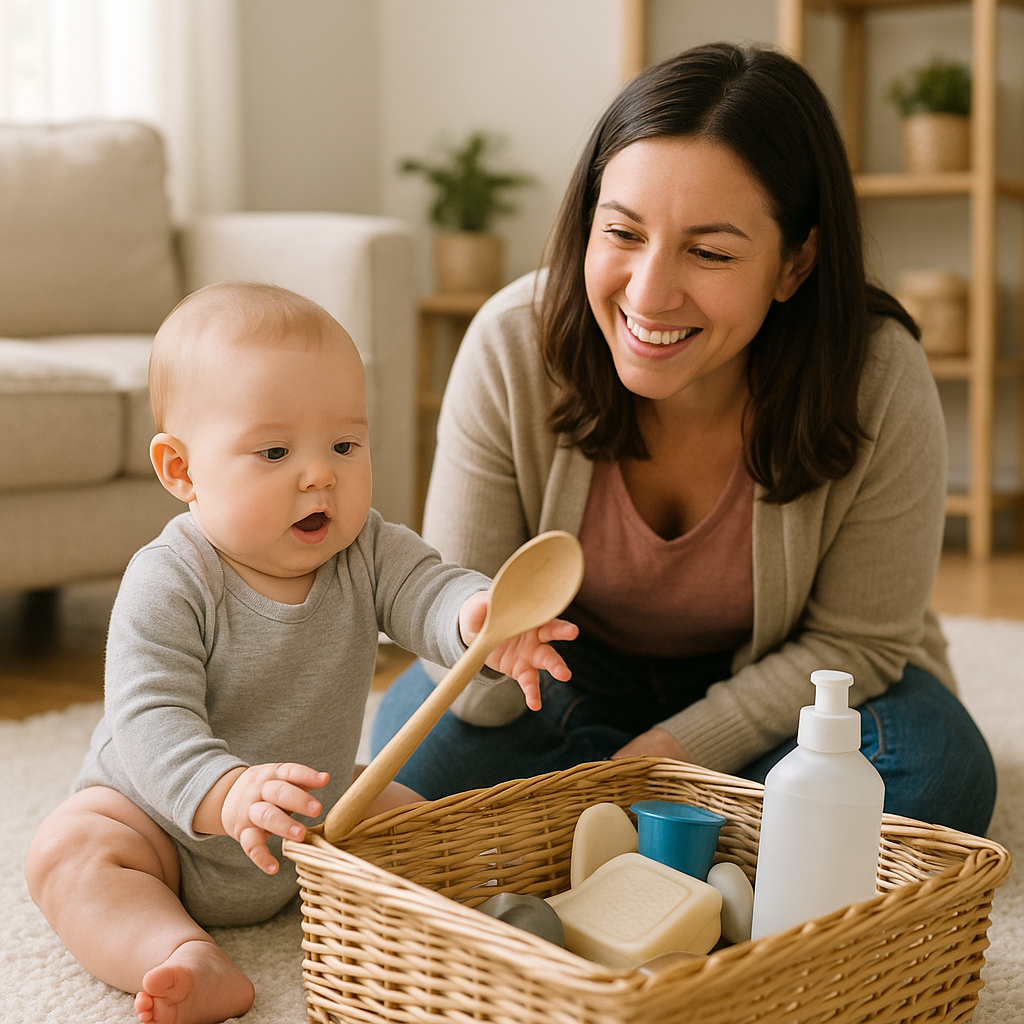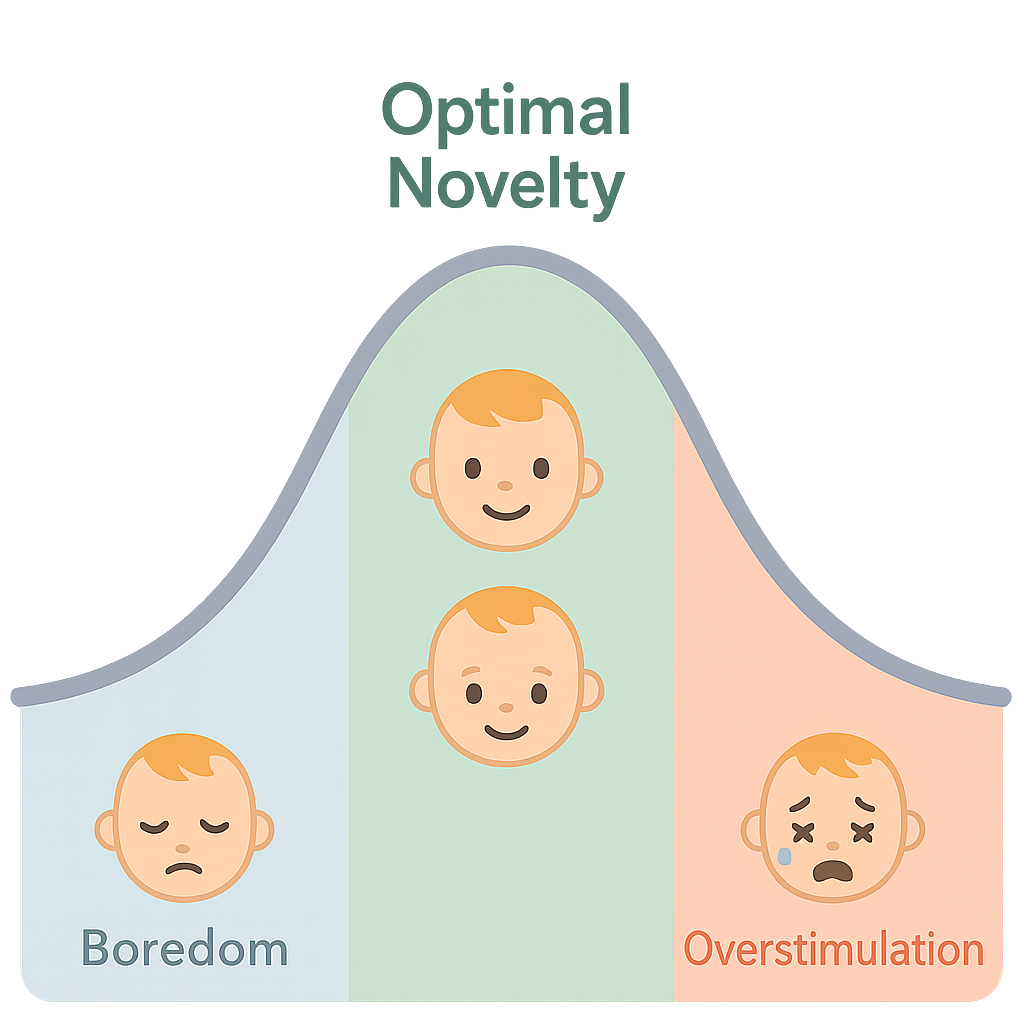Neuroscientists have found that the hippocampus—the brain’s memory and learning center—activates within 30 seconds when an infant explores a new toy independently. When you let your baby guide their play, you spark dopamine release, strengthen neural connections, and promote neural plasticity frequently throughout the day. This curiosity-driven exploration not only fuels immediate learning but also lays the foundation for lifelong cognitive skills, such as problem-solving and language acquisition. By embracing baby-led play, you create countless opportunities for sensory, motor, and emotional growth, setting the stage for a thriving mind. Let’s explore practical ways to foster your baby’s brain through play and responsive parenting.
- What is baby-led play and why does it unlock your baby’s curiosity?
- How does baby-led play differ from adult-led activities?
- How does curiosity-driven play wire new brain circuits?
- Why is the “Goldilocks” level of novelty perfect for learning?
- What role should parents play—coach, co-explorer, or quiet fan?
- Which low-cost, everyday activities fuel maximum curiosity?
- How can families adapt baby-led play for every space and need?
- Can too much structure—or too many toys—slow brain growth?
- What are the biggest myths about baby-led play and brain development?
- Quick-fire answers to parents’ top questions
- Final thoughts
What is baby-led play and why does it unlock your baby’s curiosity?
Baby-led play is when infants freely explore objects and activities of their choosing. Your baby decides whether to touch, taste, or investigate items like a wooden spoon, a soft ball, or a textured fabric, and for how long. This autonomy often triggers dopamine release, sharpens focus, and enhances memory retention, fostering cognitive development. A study from Harvard’s Center on the Developing Child found infants may shift attention up to 100 times per minute, but when an object engages them, their focus can last minutes—a significant duration for early learning.
Here’s why it works:
- Boosts dopamine: Curiosity activates reward pathways, strengthening neural connections.
- Sustains attention: Self-directed play builds executive function, like problem-solving.
- Promotes neural plasticity: Exploration refines synaptic pruning for efficient brain pathways.
How does baby-led play differ from adult-led activities?
Baby-led play encourages open-ended exploration, while adult-led play focuses on structured goals. In adult-led activities, such as sorting shapes correctly or stacking blocks in a specific order, the parent or toy dictates the “right” way to play. In contrast, baby-led play lets infants investigate objects—like a spoon or a soft ball—as puzzles to explore freely. This investigative approach often fosters intrinsic motivation, a foundation for executive function and cognitive growth as per Zero to Three. By allowing your baby to lead, you nurture their ability to make choices and solve problems independently. Try letting your baby explore a safe object without guidance today to see their curiosity spark.
Curious how routines fit in? Compare flexible exploration with structured windows in Baby Routines: Do They Boost Brain Development?.

How does curiosity-driven play wire new brain circuits?
Curiosity-driven play triggers dopamine release in the hippocampus, enhancing memory retention. A Stanford University Study found a 20–30% increase in connectivity between the hippocampus and prefrontal cortex when infants explore novel toys freely. Each action—grasping a rattle, shaking a soft toy, or inspecting a textured fabric—strengthens neural plasticity and supports synaptic pruning, creating more efficient neural pathways. These interactions build executive function, critical for problem-solving and attention. Here’s how it works:
- Grasping objects: Reinforces motor-neural connections.
- Shaking toys: Enhances sensory integration.
- Inspecting items: Boosts visual processing and memory.
Need more “neural scaffolding” ideas? See tips in Creating a Brain-Boosting Home for Your Baby.
Why is the “Goldilocks” level of novelty perfect for learning?
The ‘Goldilocks’ level of novelty—neither too simple nor too complex—optimizes infant learning. Research suggests infants engage most with experiences that balance familiarity and challenge. A Infant Behavior and Development study found that 9-month-olds focus 33% longer on moderately complex images compared to overly simple or cluttered ones. This optimal novelty strengthens neural connections and supports attention regulation. Try swapping three to four toys weekly, introducing one new household object, like a wooden spoon or a clean cloth, to maintain this ideal level without overwhelming your baby. Here are some ideas:
- Wooden spoon for banging.
- Soft ball for rolling.
- Textured scarf for touching.
For balance strategies, visit Overstimulation vs. Boredom: Balancing Baby’s Brain.

What role should parents play—coach, co-explorer, or quiet fan?
Parents should primarily act as responsive coaches, with elements of co-exploration and quiet observation, to support baby-led play. As a coach, use the serve-and-return model: observe your baby’s actions, pause for three seconds, and respond thoughtfully with comments like “You’re holding the spoon!” Such descriptive commentary can triple infant vocalizations by 12 months, boosting language development and executive function. As a co-explorer, occasionally join in, mimicking your baby’s actions to encourage social-emotional growth. As a quiet fan, step back to let curiosity drive exploration, fostering independence. A calm parental tone during interactions enhances neural connections in the prefrontal cortex. Try describing your baby’s actions today to spark their brain. Follow these steps:
- Observe your baby’s focus.
- Pause to allow independent exploration.
- Respond with encouraging words.
Feeling stressed about “doing it right”? See calming strategies in Parental Stress: How It Impacts Your Baby’s Brain.
Which low-cost, everyday activities fuel maximum curiosity?
Low-cost, everyday activities stimulate infant curiosity by engaging senses and encouraging exploration. Set up one of these activities today to spark your baby’s brain. Here are five effective options, each supporting neural connections:
- Treasure basket exploration: Include a wooden spoon, silicone whisk, and crinkly paper to engage touch and sound, promoting problem-solving.
- Mirror play: Mirrors encourage visual exploration and self-awareness, boosting social-emotional growth.
- Water bowl discovery: A shallow pan with a floating sponge stimulates tactile and visual senses, enhancing sensory integration.
- Kitchen percussion: Pots as drums develop motor skills and auditory processing, encouraging creativity.
- Fabric peekaboo: Use silk, cotton, or wool scarves to explore textures, supporting language through interactive play.
Rule of thumb: any object that can’t pass through a toilet paper tube (≈ 1.6 in / 4 cm) is generally mouth-safe.
For more screen-free play swaps, explore Screen-Free Parenting: Boosting Active Learning.
How can families adapt baby-led play for every space and need?
Families can adapt baby-led play to diverse spaces and needs with simple, inclusive strategies. These approaches stimulate curiosity, foster sensory integration, and support cognitive development, even in challenging environments. Try one of these adaptations this week to spark your baby’s brain:
- Adaptations for special needs: Consult a therapist to identify your child’s sensory profile, using bright lights for sensory seekers or soft fabrics for avoiders, applying DIR/Floortime principles to boost engagement and emotional growth.
- Small space solutions: Rotate recyclables like cardboard tubes, clean bottle caps, or fabric scraps in a shoebox “museum” to encourage exploration and problem-solving in tight quarters.
- Multigenerational home activities: Encourage grandparents to share cultural games, like peekaboo variants or object-hiding songs, fostering cultural connection and language development.
- Busy schedule strategies: Use quick, portable play kits (e.g., a bag with a rattle and scarf) for on-the-go exploration, supporting motor skills.
See more inclusion ideas in Family Involvement: How Loved Ones Boost Baby’s Brain.
Can too much structure—or too many toys—slow brain growth?
Too much structure or an overload of toys can hinder infant brain development. Research suggests that excessive structure, like over-scheduled enrichment classes, or cluttered environments with too many toys, disrupts cognitive growth. A Child Development study found that rooms with four or more electronic toys reduced parent-child verbal exchanges by 40%, limiting language development. Similarly, a 2020 study in Pediatrics noted that rigid schedules can increase cortisol levels, impairing synapse formation and neural plasticity.
These effects include:
- Reduced verbal interactions, slowing language acquisition.
- Increased stress, hindering executive function.
- Limited creativity, due to less open-ended play.
Related insight: Quality vs. Quantity Time: What Your Baby Needs.
What are the biggest myths about baby-led play and brain development?
Several myths about baby-led play and brain development can mislead parents. Understanding the realities, backed by research, helps families foster cognitive growth effectively. Embrace simple objects for play this week to support your baby’s curiosity. Here are four common myths and their realities:
Myth: “Smart” toys are essential.
Reality: Simple objects, like wooden spoons or cloth scraps, often encourage greater imagination and problem-solving, per a 2019 study in *Developmental Science.
Myth: Babies need nonstop teaching.
Reality: Autonomy in play often builds executive function faster than structured drills, enhancing neural connections.
Myth: Free exploration is unsafe.
Reality: A baby-proofed space with supervision minimizes most hazards, ensuring safe discovery.
Myth: Baby-led play delays milestones.
Reality: It often accelerates problem-solving and language skills, supporting cognitive development.
Long-term bonus: A longitudinal study tracking 6,200 children showed high curiosity in preschool predicted higher third-grade math scores, especially in low-income groups.
Quick-fire answers to parents’ top questions
-
How many minutes a day should my baby lead play?
Aim for at least two hours of awake time, split into 10–15-minute sessions. Frequent, short bursts of exploration strengthen neural connections and support cognitive development. Try 10-minute play sessions daily with objects like a rattle or soft ball to boost engagement. -
Does baby-led play delay milestones?
In most cases, no—it often accelerates milestones. The baby-led play correlates with earlier problem-solving and language acquisition, enhancing executive function. It encourages independent discovery, which drives developmental gains. -
Are interactive screens a substitute?
Not before 18 months. Screens lack the multi-sensory experiences—like touch and smell—critical for sensory integration and neural plasticity. Opt for physical toys like blocks or scarves instead. -
What if my baby only watches instead of touching?
Observation is active learning. Watching fosters cognitive processing. Demonstrate exploration—gently tap a toy and smile—then step back. -
How do I know if my baby is engaged in play?
Look for focused gaze, reaching, or vocalizing. These signs indicate active curiosity, strengthening neural plasticity. Offer one new toy weekly to maintain interest, ensuring a balance of novelty and familiarity.
Final thoughts
Allowing curiosity to guide play supports your baby’s cognitive development without expensive tools. A Pediatrics study found that self-directed exploration strengthens neural plasticity in the hippocampus and prefrontal cortex, fostering executive function and emerging self-efficacy. By stepping back, you encourage sensory play, language acquisition, and problem-solving, as highlighted throughout this article. Start with a simple toy, like a wooden spoon, today to spark curiosity.
Ready for a full day of brain-boosting moments? Download the free plan in Daily Routine for a Brain-Boosted Baby and watch your little explorer light up the world, one discovery at a time.